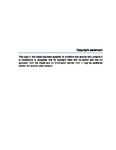MARINE INVASIVE SPECIES: FLUORESCENCE APPLICATIONS FOR BALLAST WATER REGULATORY COMPLIANCE AND USE OF FRESHWATER AS A BIOSECURITY TOOL FOR BIOFOULING
| dc.contributor.supervisor | Hall-Spencer, Jason | |
| dc.contributor.author | Trindade de Castro, Maria Cecilia | |
| dc.contributor.other | School of Biological and Marine Sciences | en_US |
| dc.date.accessioned | 2019-06-11T15:34:52Z | |
| dc.date.available | 2019-06-11T15:34:52Z | |
| dc.date.issued | 2019 | |
| dc.date.issued | 2019 | |
| dc.identifier | 10513822 | en_US |
| dc.identifier.uri | http://hdl.handle.net/10026.1/14300 | |
| dc.description | Paper published during the PhD: DOI: http://dx.doi.org/10.1016/j.marpolbul.2016.12.048; | |
| dc.description | Paper published during the PhD: DOI: http://dx.doi.org/10.1016/j.seares.2017.02.003; | |
| dc.description | Paper published during the PhD: DOI: https://doi.org/10.1080/09593330.2017.1423117; | |
| dc.description | Paper published during the PhD: DOI: http://dx.doi.org/10.5194/os-14-661-2018; | |
| dc.description | Paper published during the PhD: DOI: https://doi.org/10.1016/j.marpolbul.2018.10.013. | |
| dc.description.abstract |
The present thesis addresses the role of shipping as an unintentional and very efficient pathway for spreading aquatic non-native species around the globe, through two major vectors: ballast water and biofouling. The challenge with ballast water is that a myriad of organisms are transported across natural barriers before dispersal, transcending biogeographic regions and this wholesale movement of marine life contributes to the spread of diseases and to the homogenization of coastal habitats. The United Nations nominated the issue as one of the four greatest threats to the oceans, causing extremely severe environmental, economic and public health impacts. This research is primarily focussed on the investigation of portable instruments (fluorometers) developed to support inspections regimes on the efficiency of ballast water management systems required by international regulations and compare them to well-established research tools, e.g. flow cytometry. Viability tests of phytoplankton groups in the size range defined by these regulations in natural assemblies were conducted as well as in treated ballast water samples. An overall good correlation between the measurements taken with the fluorometers and in comparison with the flow cytometry analysis was found. Analysis of treated ballast water samples showed a large variation in the number of viable cells, however indicating the same risk on all occasions for regulatory purposes. In addition, experiments to examine the application of flow cytometry and fluorometry in characterizing natural phytoplankton communities, with special attention to cell size, found relevant results in the context of the size class distribution based on flow cytometry and semi-quantification using chlorophyll as a proxy for cell density. Found results may indicate the need for further refinement of portable fluorometers with filtration steps and in use for compliance issues. Species can also be transported on virtually all of the submerged areas on ships and so antifouling systems are used to reduce fouling. However, with increased regulation of biocides used in antifouling coatings, there is a need to find efficient and sustainable alternatives. In this regard, experiments using low salinity to kill fouling organisms in areas of the ship where it is difficult to coat and therefore tend to accumulate fouling organisms, e.g. ships sea-chest, were conducted. Results showed high levels of mortality in mature biofouling communities exposed to two hour treatment with a salinity of 7 psu. Low salinity treatments can offer an environmentally friendly biosecurity tool for minimising and controlling ships sea-chest biofouling that is simple and would not cause undue delay or costs for the ship. Large quantities of non-native species are transported daily either through ballast water or ships biofouling; however, the rate of establishment of invasive species is unclear and associated to the interplay of varied factors. Moreover, in many cases, it is difficult to disentangle the level of influence of the different vectors and pathways in this transfer. As a result, a general approach to control and minimise the unintentional transfer of non-native species through shipping should consider the adoption of integrated studies where important vectors are considered together as the best way to move forward. In the present case, it means the necessity of having biofouling under control together with ballast water. | en_US |
| dc.description.sponsorship | Conselho Nacional de Desenvolvimento Científico e Tecnológico (CNPq) | en_US |
| dc.language.iso | en | |
| dc.publisher | University of Plymouth | |
| dc.rights | CC0 1.0 Universal | * |
| dc.rights.uri | http://creativecommons.org/publicdomain/zero/1.0/ | * |
| dc.subject | Fluorescence | |
| dc.subject | Phytoplankton | |
| dc.subject | Biofouling | |
| dc.subject | Shipping | |
| dc.subject | Marine invasive species | en_US |
| dc.subject.classification | PhD | en_US |
| dc.title | MARINE INVASIVE SPECIES: FLUORESCENCE APPLICATIONS FOR BALLAST WATER REGULATORY COMPLIANCE AND USE OF FRESHWATER AS A BIOSECURITY TOOL FOR BIOFOULING | en_US |
| dc.type | Thesis | |
| plymouth.version | publishable | en_US |
| dc.identifier.doi | http://dx.doi.org/10.24382/766 | |
| dc.rights.embargoperiod | No embargo | en_US |
| dc.type.qualification | Doctorate | en_US |
| rioxxterms.version | NA | |
| plymouth.orcid.id | https://orcid.org/0000-0003-4643-1642 | en_US |
Files in this item
This item appears in the following Collection(s)
-
01 Research Theses Main Collection
Research Theses Main



